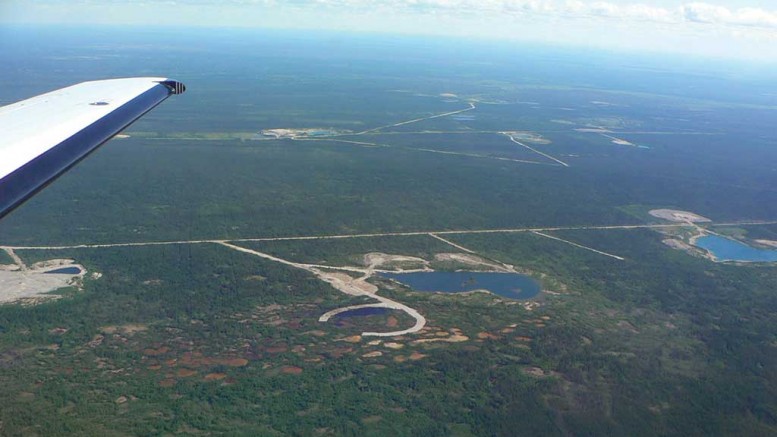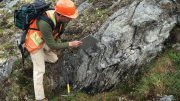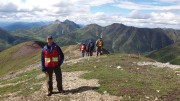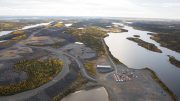VANCOUVER — Darnley Bay Resources (TSXV: DBL) has sketched out a plan to revitalize Cominco’s historic Pine Point lead-zinc mine, 42 km east of Hay River, Northwest Territories. A newly released preliminary economic assessment (PEA) models a $154-million redevelopment that would feature a 13-year mine life and total production of 1.4 billion lb. zinc and 536 million lb. lead.
Darnley Bay plucked the Pine Point asset out of bankruptcy in late 2016. The property package includes 42 zinc-lead deposits over a 68 km strike length. Cominco mined 64 million tonnes grading 7% zinc and 3.1% lead from 50 open pits and two underground deposits at the site between 1964 and 1987.

Zinc-rich crystals in a drill core sample from Darnley Bay Resources’ Pine Point zinc project. Credit: Darnley Bay Resources.
Consultants JDS Energy & Mining examined several development scenarios before settling on a mine plan wherein 10 open-pit deposits would be sequentially developed using dense media-separation plants, followed by traditional grinding and flotation to upgrade mineralized material into lead and zinc concentrates. The strategy relies on historic methods employed by Cominco.
“The study demonstrates relatively low capital costs when compared to similar projects. We examined a variety of mining scenarios, and realized that the methods applied by Cominco during Pine Point’s production history were the best option,” Darnley Bay president and CEO Jamie Levy said during a conference call. “We’ll be moving forward with feasibility work, and I’d point out there remain several opportunities to improve the economics, including the addition of underground resources and several areas of the mineralized trend that remain unexplored.”
The PEA includes resources of 25.8 million measured and indicated tonnes grading 2.9% zinc and 1.12% lead, and another 3.7 million inferred tonnes of 2.9% zinc and 0.8% lead.
Darnley Bay says it would leverage a combination of portable and fixed crushers, and dense media separation plants located near each deposit, with pre-concentrate trucked to a central 1,800-tonne-per-day mill for standard grinding and flotation to produce a final concentrate. The company would then truck concentrate to the Hay River railway facility, 65 km west.
Pine Point hosts Mississippi Valley-type deposits, which are classified as carbonate-hosted lead-zinc sulphide deposits that are typically known for moderate to high base metal grades, non-complex metallurgy and processing/beneficiation characteristics that yield problem-free concentrates.

Historic pits at the Pine Point lead-zinc property in the Northwest Territories. Credit: Darnley Bay.
The project also has twin underground deposits — R190 and X25 — that could play a role as the company moves towards feasibility-level engineering. Pine Point’s underground resource is 1 million measured and indicated tonnes of 10.98% zinc and 5.3% lead at R190, and 2.1 million tonnes of 6.7% zinc and 2.3% lead at X25.
Levy added that metallurgical recovery rates could be improved, and there is potential for discoveries along large portions of the westernmost leases, which remain under-explored due to distances from the original Pine Point concentrator.
Lead and zinc mineralization in the Pine Point area has reportedly been found along three main trends known as the North trend, Main trend and South trend. Darnley Bay announced a 3,500-metre drill program in March, which is intended to upgrade historic resources and explore for more deposits. Exploration by past operators includes 1.3 million metres of core drilling in an estimated 18,406 drill holes. There are 54 undeveloped lead-zinc deposits across the property package.

An infrastructure map of the Pine Point property package, 42 km due east of Hay River, Northwest Territories. Credit: Darnley Bay.
In December 2016, Darnley Bay raised nearly $7.7 million by issuing 25 million shares at 20¢, and another 10.6 million flow-through shares at 25¢. Lukas Lundin’s Zebra Holdings and Rob McEwen’s Evanachan jointly subscribed for 70% of the shares.
The company has traded within a 52-week range of 2.5¢ to 57¢ per share, and closed at 26.5¢ at press time. Darnley Bay has 132 million shares outstanding for a $35-million market capitalization.






Be the first to comment on "Darnley Bay outlines plans for Pine Point revival"